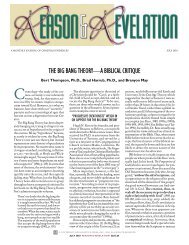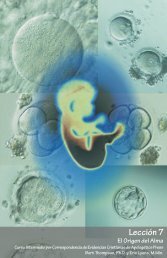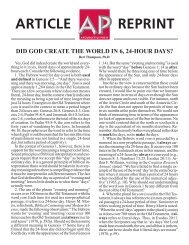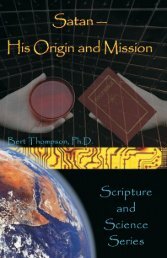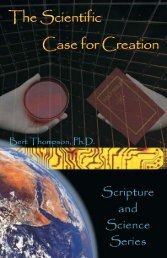Origins: Random Chance or Intelligent Design? - Apologetics Press
Origins: Random Chance or Intelligent Design? - Apologetics Press
Origins: Random Chance or Intelligent Design? - Apologetics Press
- No tags were found...
You also want an ePaper? Increase the reach of your titles
YUMPU automatically turns print PDFs into web optimized ePapers that Google loves.
Lesson 1<strong>Origins</strong>: <strong>Random</strong> <strong>Chance</strong> <strong>or</strong> <strong>Intelligent</strong> <strong>Design</strong>?<strong>Apologetics</strong> <strong>Press</strong> Advanced Christian Evidences C<strong>or</strong>respondence Course
ORIGINS: RANDOM CHANCEOR INTELLIGENT DESIGN?Yucca flowers are quite unique, in that they can only be pollinated by asingle insect—the yucca moth. The physiological design of the yucca flowermakes pollination impossible by conventional means. Commonly, insects suchas honey bees pollinate plants as they fly from flower to flower seeking food.Most of the time, both honey bees and plants benefit from the bees’ activity.The honey bee gets some food, and the plant gets pollinated. Honey bees collectpollen from the anthers (the male reproductive part of a flower) in specialpollen baskets on their hind legs, to be taken back to the hive f<strong>or</strong> the bees’use. However, honey bees are messy gatherers of food, and as such, pollengets stuck on the hairs of their bodies. When the bees visit their next flower,some of that pollen brushes off onto the flower, and if it sticks to the stigma(female reproductive part of the flower), pollination takes place. Hundreds ofvarieties of plants are pollinated in this way.Pollination of the yucca flower is different. When the yucca moth comes toa yucca flower, it collects a ball of pollen, and then lays eggs in the ovary ofthe female part of the flower. Afterward, it climbs to the top of the female partof the flower and places the ball of pollen on the stigma—exactly where itneeds to be f<strong>or</strong> pollination to occur. Once it is pollinated, the yucca flower canproduce seeds in its ovary. The yucca moth caterpillars eat some of the seeds,but many seeds are left over to produce new yucca plants. Because the yuccamoth caterpillars eat only yucca seeds, and because the yucca plant is pollinatedonly by yucca moths, the moths and the plant depend on each otherf<strong>or</strong> survival. This symbiotic relationship demonstrates the complexity and obviousdesign observed throughout nature. Evolutionists would have us believethat this pollination process came into existence by mere chance overmillions of years, yet both the moth and the plant are vital to one another’sexistence, and neither could have waited f<strong>or</strong> the other to evolve.If we attribute the pollination process of the yucca plant to design, thenthe question becomes—who is the designer? Where we see evidence of design,it only makes sense to look f<strong>or</strong> the designing agent. Whether it be a housefashioned out of tongue depress<strong>or</strong>s, <strong>or</strong> a stealth fighter, someone was responsiblef<strong>or</strong> the overall design of the finished product. F<strong>or</strong> instance, if we werewalking through the Sahara Desert and came across a laptop computer, wewould not think f<strong>or</strong> a moment that it arrived there by random chance. Wewould recognize immediately that the computer was the end product of designand manufacturing. But what about things that are not manmade? Whatabout the Universe <strong>or</strong> the human body? Evolutionists quickly disregard anynotion that either the Universe <strong>or</strong> the human body shows signs of design, becausethey realize the implications of such a notion. By admitting there is inherentdesign—whether it is the usefulness of the human hand <strong>or</strong> the “justright” atmospheric conditions of the Earth—the necessity of an intelligentdesigner immediately arises.1
F<strong>or</strong> instance, the Earth is slanted on its axis exactly right—at a tilt of 23.5°.If it were not tilted, but instead sat straight up in its <strong>or</strong>bit around the Sun, therewould be no seasons. The tropics would be hotter, and the deserts would getbigger. If the tilt moved all the way over to 90°, much of the Earth would switchbetween very cold winters and very hot summers. In addition, the Earth ispoised 240,000 miles from the Moon, whose gravitational pull is responsiblef<strong>or</strong> ocean tides. If the Moon were moved closer to the Earth by just onefifth,the tides would be so en<strong>or</strong>mous that twice a day they would reach 35-50 feet high over most of the Earth’s surface. Yet evolutionists are unwillingto acknowledge the obvious design in the exact placement of the Earth andthe Moon.But the m<strong>or</strong>e that design is discovered in the w<strong>or</strong>ld (<strong>or</strong> Universe!) aroundus, the m<strong>or</strong>e evolutionists are faced with the daunting task of trying to dreamup realistic explanations of how it is that so many things in nature have preciselythe c<strong>or</strong>rect measurements and/<strong>or</strong> relationships. The statistical probabilityof everything happening by random chance is both unthinkable andimpossible. Even evolutionists, in their m<strong>or</strong>e candid moments, are willing toadmit as much. Richard Dawkins of Oxf<strong>or</strong>d University noted: “The m<strong>or</strong>e statisticallyimprobable a thing is, the less we can believe that it just happenedby blind chance. Superficially the obvious alternative to chance is an intelligent<strong>Design</strong>er” (1982, 94:30, emp. added). We suggest, however, that itis not at all “superficial” to attribute purposeful design to an “intelligent <strong>Design</strong>er.”Rather, the available evidence permits no other rational conclusion.Consider, if you will, some of that evidence.In speaking of the human body, one evolutionist wrote:When you come right down to it, the most incredible creation in theuniverse is you—with your fantastic senses and strengths, your ingeniousdefense systems, and mental capabilities so great you can neveruse them to the fullest. Your body is a structural masterpiece m<strong>or</strong>eamazing than science fiction (Guinness, 1987, p. 5).Could a rational person really be expected to conclude that the “structural masterpiece”we call the human body—with all of its “ingenious” systems and its“highly endowed <strong>or</strong>ganization”—is the result of undirected evolutionaryprocesses operating over eons of time in nature? Or is it m<strong>or</strong>e logical to concludethat the body is the result of purposeful design by a Master <strong>Design</strong>er?From an <strong>or</strong>ganizational standpoint, the human body may be considered atfour different levels. First, there are cells, which represent the smallest unit oflife. Second, there are tissues (muscle tissue, nerve tissue, etc.), which aregroups of the same types of cells carrying on the same kind of activity. Third,there are <strong>or</strong>gans (heart, liver, etc.), which are groups of tissues w<strong>or</strong>king togetherin unison. Fourth, there are systems (reproductive system, circulat<strong>or</strong>ysystem, etc.), which are composed of groups of <strong>or</strong>gans carrying out specificbodily functions. To the unbiased, it should be obvious that the physical bodyhas been marvelously designed and intricately <strong>or</strong>ganized f<strong>or</strong> the purpose offacilitating human existence upon the Earth.2
A human body is composed of over 250 different kinds of cells (red bloodcells, white blood cells, muscle cells, fat cells, nerve cells, etc.—Baldi, 2001, p.147), totaling approximately 100 trillion cells in an average adult (Fukuyama,2002, p. 58). These cells come in a variety of sizes and shapes, with differentfunctions and life expectancies. Each cell possesses <strong>or</strong>ganelles such as ribosomes,mitochondria, Golgi apparatus, endoplasmic reticulum, and a nucleus—all of which play vital roles in keeping the <strong>or</strong>ganism alive. While all of thesemicroscopic <strong>or</strong>ganelles point to an intelligent designer, the truly amazing intricatecomplexity of a cell is observed within the nucleus, f<strong>or</strong> it is within thenucleus that the DNA—<strong>or</strong> genetic code—is to be found.If transcribed into English, the chemical code (deoxyribonucleic acid—DNA)in the human genome (i.e, in a spermatozoon <strong>or</strong> ovum) would fill a 300-volumeset of encyclopedias of approximately 2,000 pages each (Baldi, p. 21).Yet just as amazing is the fact that all the genetic inf<strong>or</strong>mation needed to reproducethe entire human population (around six billion people) could beplaced into a space of about one-eighth of a cubic inch. The intricate andcomplex nature of the DNA molecule—combined with the staggering amountof chemically coded inf<strong>or</strong>mation that it contains—speaks unerringly to thefact that this “supermolecule” simply could not have come into existence dueto blind chance and random natural f<strong>or</strong>ces operating through eons of time,as evolutionists have claimed. This is not an adequate explanation f<strong>or</strong> the inherentcomplexity of the DNA molecule. Does coded inf<strong>or</strong>mation happen bychance? And could the decoding system (RNA and ribosomes) just happenby chance as well? Hardly.In the human body, there are numerous tissues (e.g., muscle tissues, nervetissues, etc.). In fact, a single human has m<strong>or</strong>e than 600 muscles (containingabout six billion muscle fibers), composing about 40% of the body’s weight.Muscles are the “engines” that the body uses to provide the power f<strong>or</strong> movement.Some muscles are tiny (such as those regulating the amount of lightentering the eye), while others (like those in the legs) are massive.Muscles may be classified either as “voluntary” (i.e., under the control ofthe human will), <strong>or</strong> “involuntary” (i.e., not under control of the will). The voluntarymuscles of the arms, f<strong>or</strong> example, are attached to the bones by toughc<strong>or</strong>ds of connective tissue called tendons. One must “think” in <strong>or</strong>der to movethese muscles. The involuntary muscles are those whose contraction and relaxationare not controlled consciously (e.g., the heart and intestines). Somemuscles are both voluntary and involuntary (e.g., the muscles controlling theeyelids, and the diaphragm). All muscles, in one way <strong>or</strong> another, are regulatedby the nervous system. The design inherent in voluntary and involuntarymuscles is utterly incredible.If it is clear that an automobile engine was intelligently designed, why is itnot reasonable to draw the same conclusion with reference to muscles? JohnLenihan, even though an evolutionist, wrote: “The body’s engines [muscles3
—BT/BH]...demonstrate some surprisingly modern engineering ideas” (1974,p. 43). Who initiated these “engineering ideas”? The answer, of course, isthe Great Engineer, God.The SkinThe skin is the largest single <strong>or</strong>gan of the human body. It consists of threeareas: (a) the skin layers; (b) the glands; and (c) the nails. If the skin of a 150-pound man were spread out, it would cover 20 square feet of space and weighabout 9 pounds. The skin is also a very busy area. “A piece of skin the size ofa quarter contains 1 yard of blood vessels, 4 yards of nerves, 25 nerve ends,100 sweat glands, and m<strong>or</strong>e than 3 million cells” (Youmans, 1979, 17:404d).The skin abs<strong>or</strong>bs ultraviolet rays from the Sun, and uses them to convert chemicalsinto vitamin D, which the body needs f<strong>or</strong> the utilization of calcium. It retainsthe fluids in the body, and yet still is permeable enough f<strong>or</strong> perspirationto penetrate in <strong>or</strong>der to cool the body. And, the skin is the primary means ofdefense against bacteria and other harmful <strong>or</strong>ganisms. Man has yet to developa durable material that can perf<strong>or</strong>m the many functions that the skincarries out on a daily basis.The EyeOne of the most f<strong>or</strong>ceful evidences of design within the human body isthe eye. Even Charles Darwin struggled with the problem of an <strong>or</strong>gan so complexas the eye evolving via naturalistic processes. In The Origin of Specieshe wrote:To suppose that the eye with all its inimitable contrivances f<strong>or</strong> adjustingthe focus to different distances, f<strong>or</strong> admitting different amountsof light, and f<strong>or</strong> the c<strong>or</strong>rection of spherical and chromatic aberration,could have been f<strong>or</strong>med by natural selection, seems, I freely confess,absurd in the highest sense(1859,p.170,emp.added).However, in spite of his misgivings, Darwin went on to argue that the eye had,in fact, been produced by natural selection through an evolutionary process.Darwin, of course, is not the only one to be troubled by what appears to beobvious evidence of design in the eye. Evolutionist Robert Jastrow lamented:The eye is a marvelous instrument, resembling a telescope of the highestquality,with a lens, an adjustable focus, a variable diaphragm f<strong>or</strong>controlling the amount of light, and optical c<strong>or</strong>rections f<strong>or</strong> sphericaland chromatic aberration. The eye appears to have been designed;no designer of telescopes could have done better. Howcould this marvelous instrument have evolved by chance, througha succession of random events? (1981, pp. 96-97, emp. added).Considering how extremely complex the mechanism of the eye is knownto be, it is easy to understand why Dr. Jastrow would make such a comment.Light images from the environment enter the eye (at approximately 186,000miles per second) through the iris, which opens and shuts like the diaphragmof a camera to let in just the right amount of light. The images move through4
automobile accelerat<strong>or</strong> pedal). They act like hydraulic jacks when a persontip-toes. They catapult a person as he jumps. And feet act as a cushionf<strong>or</strong> the legs when one is running. All of these features are quite helpful—especially in view of the fact that an average person will walk about 65,000miles in his/her lifetime (equivalent to traveling around the w<strong>or</strong>ld m<strong>or</strong>e thantwo-and-a-half times). The human skeletal system demonstrates brilliant design,which shows that there must have been a brilliant <strong>Design</strong>er behind it.The Circulat<strong>or</strong>y SystemThe circulat<strong>or</strong>y system—which consists of the heart, arteries, arterioles, vessels,and capillaries—has several functions. First, it transp<strong>or</strong>ts digested foodparticles to the various parts of the body. Second, it takes oxygen to the cellsf<strong>or</strong> burning food, thus producing heat and energy. Third, it picks up wastematerials and carries them to the <strong>or</strong>gans that eliminate them from the body.The heart is an involuntary muscle that beats about 100,000 times a day,<strong>or</strong> nearly 40,000,000 times in a year. It pumps about 1,800 gallons of blooda day. In a lifetime, a heart will pump some 600,000 metric tons of blood!Evolutionists Miller and Goode conceded that “f<strong>or</strong> a pump that is keepingtwo separate circulat<strong>or</strong>y systems going in perfect synchronization, it is hardto imagine a better job of engineering” (1960, p. 68, emp. added). Yet thisamazing device, which they admitted is “hard to describe as anything sh<strong>or</strong>tof a miracle” (p. 64, emp. added), was produced by blind f<strong>or</strong>ces?The Nervous SystemThe brain, located in the protective case called the skull, is the most highlyspecialized <strong>or</strong>gan in the body. The late Isaac Asimov, well-known sciencewriter and humanist, once stated that man’s brain is “the most complexand <strong>or</strong>derly arrangement of matter in the universe” (1970, p. 10). Whoarranged it? Paul Davies, atheistic profess<strong>or</strong> of mathematics and physics atthe Universe of Adelaide in Australia, observed that the human brain is “themost developed and complex system known to science” (1992, 14[5]:4).It is not just the brain that is “difficult to explain by evolution.” Were spaceto permit, we could examine numerous other body systems (e.g., digestive,reproductive, etc.), each of which provides clear and compelling evidence ofdesign. Atheistic philosopher Paul Ricci has suggested: “Although many havedifficulty understanding the tremendous <strong>or</strong>der and complexity of functionsof the human body (the eye, f<strong>or</strong> example), there is no obvious designer”(1986, p. 191, emp. added). The only people who “have difficultyunderstanding the tremendous <strong>or</strong>der and complexity” found in the Creationare those who have “refused to have God in their knowledge” (Romans 1:28).Such people can parrot the phrase that “there is no obvious designer,” but inlight of the actual evidence, their arguments are not convincing.6
Asimov, Isaac (1970), “In the Game of Energy and Thermodynamics You Can’tEven Break Even,” Smithsonian Institute Journal, pp. 4-10, June.Baldi, Pierre (2001), The Shattered Self (Cambridge, MA: MIT <strong>Press</strong>).Darwin, Charles (1859), The Origin of Species (Cambridge, MA: Harvard University<strong>Press</strong>; a facsimile of the first edition).Davies, Paul (1992), “The Mind of God,” Omni, 14[5]:4, February.Dawkins, Richard (1982), “The Necessity of Darwinism,” New Scientist, 94:130-132, April 15.Fukuyama, Francis (2002), Our Posthuman Future (New Y<strong>or</strong>k: Ferrar, Straus, andGiroux).Gribbin, John (1983), “Earth’s Lucky Break,” Science Digest, 91[5]:36-37,40,102, May.Guinness, Alma E., ed. (1987), ABC’s of the Human Body (Pleasantville, NY:Reader’s Digest).Jastrow, Robert (1981), The Enchanted Loom: Mind in the Universe (NewY<strong>or</strong>k: Simon and Schuster).Lawton, April (1981), “From Here to Infinity,” Science Digest, 89[1]:98-105,January/February.Lenihan, John (1974), Human Engineering (New Y<strong>or</strong>k: John Braziller).Miller, Benjamin and Goode, Ruth (1960), Man and His Body (New Y<strong>or</strong>k: Simonand Schuster).Ricci, Paul (1986), Fundamentals of Critical Thinking (Lexington, MA: Ginn<strong>Press</strong>).Science Digest (1981), 89[1]:124, January/February.Sedeen, Margaret (1986), in The Incredible Machine (Washington, D.C.: NationalGeographic Society).Youmans, W.B. (1979), in W<strong>or</strong>ld Book Encyclopedia (Chicago, IL: W<strong>or</strong>ld Book/Childcraft International).Published by <strong>Apologetics</strong> <strong>Press</strong>, Inc. Additional copies may be <strong>or</strong>deredfrom our offices at: 230 Landmark Drive, Montgomery, Alabama36117, USA, 334/272-8558. If you wish to have the testp<strong>or</strong>tion of the lesson graded, return it to the church <strong>or</strong> individualwho provided you with the lesson. Returning it to <strong>Apologetics</strong> <strong>Press</strong>will result in your receiving a delayed response. Copyright © 2003www.<strong>Apologetics</strong><strong>Press</strong>.<strong>or</strong>g
Questions—Lesson 1Write TRUE <strong>or</strong> FALSE in the blanks bef<strong>or</strong>e the following statements.________________________________________________________________________________1. Honey bees are the primary pollinat<strong>or</strong>s of theYucca plant.2. The liver is the largest <strong>or</strong>gan in the human body.3. Light images enter the eyes at approximately186,000 miles per second.4. Yucca caterpillars only eat seeds from the Yuccaplant.5. The average human body is composed of 100 trillioncells.6. The human body produces Vitamin K from sunlight.7. The human foot contains 26 bones that functiontogether.8. The Earth is slanted on its axis exactly right, at13.5°.Circle the c<strong>or</strong>rect answer(s).1. Which of the following houses the genetic code (DNA) f<strong>or</strong> humans?(a) Golgi apparatus (b) Cell wall (c) Nucleus (d) Ribosomes2. 1,087 feet per second is the:(a) Speed of sound(c) Speed the Earth is<strong>or</strong>biting the Sun(b) Speed of light(d) Speed nerve signals go tothe brain3. The heart beats approximately how many times in a seven-dayweek:(a) 100,000 (b) 1,000,000 (c) 550,000 (d) 700,000
4. The distance (in miles) from the Earth to the Moon is:(a) 570,000 (b) 240,000 (c) 750,000 (d) 420,0005. If transcribed into English, the DNA in the human genome wouldfill a:(a) 300-volume set of encyclopedias,each containing2,000 pages(c) 200-volume set of encyclopedias,each containing1,000 pages(b) 250-volume set of encyclopedias,each containing 2,000pages(d) 150-volume set of encyclopedias,each containing 1,000pagesMatch the related concepts (place the c<strong>or</strong>rect letter in the spaceprovided by each number).1. ____ Number of different kindsof cells in the body2. ____ Number of muscles inthe human body3. ____ The number of nerveendings conveying messagesto the eye4. ____ The number of audit<strong>or</strong>yrecept<strong>or</strong>s that transmitvibrations to the brain5. ____ The amount (in metrictons) of blood the heartwill pump in a lifetime6. ____ The distance (in miles)that the average personwalks in his/her lifetime7. ____ The number of gallons ofblood the heart pumpsin a dayA. 137 millionB. 600,000C. 250D. 65,000E. 1,800F. 600G. 25,000
1. The ___________ has been called the most complex matter inthe Universe.2. Paul Ricci stated: “Although many have difficulty understandingthe tremendous <strong>or</strong>der and complexity of functions of thehuman body, there is no obvious __________________.”3. If the Moon were moved closer to the Earth by just one-fifth thecurrent distance, the ________________ would be so en<strong>or</strong>mousthat twice a day they would reach 35-50 feet high over most ofthe Earth’s surface.4. Charles Darwin, in commenting about the possibility of the eyef<strong>or</strong>ming by natural processes, stated that “it seems, I freely confess,______________ in the highest sense.”5. Evolutionist Robert Jastrow lamented: “The eye appears tohave been designed; no designer of ____________ could havedone better.”NAME _____________________________________________ADDRESS_____________________________________________________________________________________________CITY __________________________STATE ____________POSTAL CODE ________________DATE ______________Copyright © 2003—<strong>Apologetics</strong> <strong>Press</strong>, Inc.




